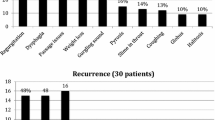Abstract
Background
Long-term outcomes and predictors of success after transoral stapling for Zenker diverticulum are still unclear.
Methods
Between 2001 and 2010, 91 patients with Zenker diverticulum underwent transoral stapling under general anesthesia. Since 2008, the technique was modified by applying traction sutures to ease engagement of the common septum inside the stapler jaws. Perioperative variables, distribution of symptoms, and outcome of surgery were analyzed. Long-term results were compared between patients undergoing standard versus modified technique of transoral stapling.
Results
The transoral approach was successfully completed in 79 (86.8 %) patients with a median age of 74 years. Overall morbidity was 5 %, and there was no mortality. The median length of hospital stay was 2 days. Six patients were lost to follow-up. After a median follow-up of 53 (range, 12–114) months, an improvement of dysphagia and regurgitation scores (p < 0.001) and a reduction in the number of pneumonia episodes per year (p < 0.001) was recorded. The long-term success rate of the procedure was 80.1 %. At a median time of 12 months, 14 patients complained of recurrent symptoms, 7 of whom needed an open (n = 4) or transoral (n = 3) reoperation. Use of traction sutures resulted in a greater long-term success compared with the standard procedure (p = 0.04).
Conclusions
Transoral stapling is a safe and effective technique. A repeat procedure is feasible in case of recurrent diverticulum. The use of traction sutures applied at the apex of the common septum before stapling might increase the long-term success of the technique.




Similar content being viewed by others
References
Mosher H (1917) Webs and pouches of the esophagus, their diagnosis and management. Surg Gynecol Obstet 25:175–187
Nyrop M, Svendstrup F, Yorgensen KE (2000) Endoscopic CO2 laser therapy of Zenker’s diverticulum. Experience from 61 patients. Acta Otolaryngol 543:232–234
Lerut T, Van Raemdonck D, Guelinckx P, Dom R, Geboes K (1992) Zenker’s diverticulum: is a myotomy of the cricopharyngeus useful? How long should it be? Hepatogastroenterology 39:100–104
Collard JM, Otte JB, Kestens PJ (1993) Endoscopic stapling technique of esophagodiverticulostomy for Zenker’s diverticulum. Ann Thorac Surg 56:573–576
Martin-Hirsch D, Newbegin C (1993) Autosuture GIA gun: a new application in the treatment of hypopharyngeal diverticula. J Laringol Otol 107:723–725
Narne S, Bonavina L, Guido E, Peracchia A (1993) Treatment of Zenker’s diverticulum by endoscopic stapling. Endosurgery 1:118–120
Aly A, Devitt PG, Jamieson GG (2004) Evolution of surgical treatment for pharyngeal pouch. Br J Surg 91:657–664
Sen P, Lowe DA, Farnan T (2005) Surgical interventions for pharyngeal pouch. Cochrane Database Syst Rev 3:CD004459
Bonavina L, Bona D, Abraham M, Saino G, Abate E (2007) Long-term results of endosurgical and open surgical approach for Zenker’s diverticulum. World J Gastroenterol 13:2586–2589
Peracchia A, Bonavina L, Narne S, Segalin A, Antoniazzi L, Marotta G (1998) Minimally invasive surgery for Zenker diverticulum: analysis of results in 95 consecutive patients. Arch Surg 133:695–700
Panos MZ, Walt RP, Stevenson C, Langman MJS (1995) Rising death rate from non-malignant disease of oesophagus (NMOD) in England and Wales. Gut 36:488–491
Rizzetto C, Zaninotto G, Costantini M, Bottin R, Finotti E, Zanatta L, Guirroli E, Ceolin M, Nicoletti L, Ruol A, Ancona E (2008) Zenker’s diverticula: feasibility of a tailored approach based on diverticulum size. J Gastrointest Surg 12:2057–2065
Richtsmeier WJ (2005) Myotomy length determinants in endoscopic staple-assisted esophagodiverticulostomy for small Zenker’s diverticula. Ann Otol Rhinol Laryngol 114:341–346
Nicholas BD, Devitt S, Rosen D, Spiegel J, Boon M (2010) Endostitch-assisted endoscopic Zenker’s diverticulostomy: a tried approach for difficult cases. Dis Esophagus 23:296–299
Disclosures
Drs. Bonavina, Rottoli, Bona, Siboni, Russo, and Bernardi have no conflict of interest or financial ties to disclose.
Author information
Authors and Affiliations
Corresponding author
Rights and permissions
About this article
Cite this article
Bonavina, L., Rottoli, M., Bona, D. et al. Transoral stapling for Zenker diverticulum: effect of the traction suture-assisted technique on long-term outcomes. Surg Endosc 26, 2856–2861 (2012). https://doi.org/10.1007/s00464-012-2261-0
Received:
Accepted:
Published:
Issue Date:
DOI: https://doi.org/10.1007/s00464-012-2261-0




